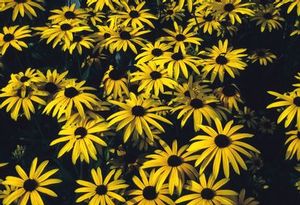Printed at http://www.newmoonnursery.com/index.cfm/

Black-eyed Susan is a good perennial choice for butterflies and other pollinators, naturalizing, and rain gardens.
Rudbeckia fulgida v. deamii
Black-eyed Susan
Native to North America
FIRST IMPRESSIONS: Rudbeckia fulgida var. deamii is a low maintenance and resilient wildflower – thriving in most sunny sites. Striking summer flowers are beloved for their golden orange rays and chocolate brown cones. Butterflies flock to the blooms and songbirds relish the seeds in sunny sites with average soil.
HABITAT & HARDINESS: Rudbeckia fulgida var. deamii occurs in the central United States in Illinois, Indiana and Ohio.
Habitats are typically mesic or hydric creek banks, calcareous seeps, open woods and low roadsides.
Plants are hardy from USDA Zones 4-9.
PLANT DESCRIPTION: Rudbeckia fulgida var. deamii is a dense branching perennial.
Stems are sturdy and pubescent with leathery dark green oblong leaves. The blades are about 5” long and 2” wide. The large size is consistent even on the upper leaves unlike other species that have upper leaves reduced in size. The leaves are toothed and pubescent.
Flower heads are borne in profusion almost covering the foliage. Each daisy-like head averages 1-2” across with 12-21 golden-yellow rays that encircle a robust dark brown cone loaded with disc florets.
Flowering begins in late summer and continues until autumn. Dense chocolate colored seed heads form and remain into early winter.
Plants grow 3’ tall with 2’ spread.
CULTURAL & MAINTENANCE NEEDS: The ideal site for Rudbeckia fulgida var. deamii has full sun and fertile well drained soil. Plants adapt to clay, alkaline or acid pH, gravelly soils and tolerate part sun, heat and drought.
This species is strong, vigorous and pest resistant. In the hot humid south, however, plants need good air circulation and occasional division to discourage foliar diseases.
Deadheading can extend the season of bloom but will remove the seed that are savored by songbirds.
LANDSCAPE USES: This is a good choice for a Wildlife Garden, Cut Flower Garden, Prairie or Meadow. Plants are also used as Butterfly Nectar Plants or as part of a Grouping or Mass Planting. Rudbeckia fulgida var. deamii has Showy Blooms and is appropriate for Cottage Gardens, Deer Resistant Plantings, Water-wise Landscapes, Low Maintenance Plantings, Perennial Borders and Roadsides.
COMPANION & UNDERSTUDY PLANTS: Try pairing Rudbeckia fulgida var. deamii with Coreopsis major, Echinacea purpurea, Phlox paniculata, Liatris aspera, Schizachyrium scoparium and Andropogon gerardii.
Rudbeckia fulgida var. fulgida would be a worthy substitute if needed.
TRIVIA: Native bees, small butterflies, skippers, pollinating flies and beetles seek nectar and pollen from the flowers. Caterpillars of several moths feed on the foliage and flowers. Mammalian herbivores occasionally browse the foliage and songbirds relish the nutlike seed.
Rudbeckia fulgida var. deamii received the Royal Horticultural Society’s prestigious Award of Garden Merit in 1993.
Rudbeckia fulgida var. deamii can be differentiated from similar species because it has more pubescent stems, smaller flowerheads than some and large upper leaves.
The generic name Rudbeckia is in honor of 17th century Swedish botanists Olof Rudbeck and his son Olof. The specific epithet fulgida is from the Latin word for “shiny” because of the glowing golden flower rays. The variety name deamii was named for American botanist Charles Deam (1865-1953) who discovered the species in the wild in Indiana.
Height:
3 ftSpread:
2 ftSpacing:
2 ftUSDA Hardiness Zone:
4-9Bloom Color:
Yellow OrangeRudbeckia fulgida v. deamii Characteristics
Attracts Wildlife
- Butterflies
- Songbirds
- Pollinators
Attributes
- Dried Flower
- Cut Flower
Exposure
- Full Sun to Partial Shade
Flowering Months
- September
- August
- October
Foliage Color
- Green
Juglans nigra Tolerance (Black Walnut)
- Yes
Soil Moisture Preference
- Moist to Dry
Interesting Notes:
For more information on this plant, visit the USDA PLANTS Database: http://plants.usda.gov/java/profile?symbol=RUFUD
